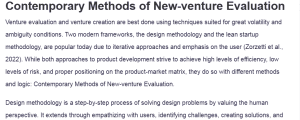Contemporary Methods of New-venture Evaluation
Venture evaluation and venture creation are best done using techniques suited for great volatility and ambiguity conditions. Two modern frameworks, the design methodology and the lean startup methodology, are popular today due to iterative approaches and emphasis on the user (Zorzetti et al., 2022). While both approaches to product development strive to achieve high levels of efficiency, low levels of risk, and proper positioning on the product-market matrix, they do so with different methods and logic: Contemporary Methods of New-venture Evaluation.
Design methodology is a step-by-step process of solving design problems by valuing the human perspective. It extends through empathizing with users, identifying challenges, creating solutions, and designing mini-models followed by evaluations. The process is based on confronting ideas, cooperation, and understanding customers’ requirements. A good illustration in real life is the development of IDEO’s human-centered design toolkit.
The design consultancy firm IDEO used design methodology to assist organizations in developing nations to come up with unique solutions to social challenges. The IDEO’s team interviewed the end-users in workshops, understood local problems, and created effective solutions with the communities (Schatz et al., 2022). Notably, this iterative process enabled ideas to be fine-tuned ‘in real time’, helping organizations bring sustainable products and services to fruition.
Another example is the concept behind the Apple iPhone and its actual design on the market. Its design team aimed to create a useful device, carrying out a corresponding study to discover how people used other smartphones. The discoveries were then used to develop the feature for the iPhone.
The lean startup model popularized by Eric Ries is based on the principles of working with minimally viable products, practicing such values as MVP testing, fast experiments, and authentic learning. Unlike conventional methodology that mobilizes huge amounts of time in planning sessions, the lean startup focuses on creating a mere ‘minimum viable product’ (MVP) that is a raw product form to get customer response. Notably, this feedback helps the company tailor the product in the subsequent stages of the product development process.
One of the most recognizable examples of using this approach is Dropbox. Before investing most of its funds in software development, Dropbox’s creator, Drew Houston, made a scratch visual animation, a smooth service connecting people to files. With many creating accounts for the service, the video proved the concept despite having no fully working product (Gamnis et al., 2022). Due to such a response, Dropbox gets funding and develops its software, knowing market needs exist.
While the two methods are centered on eliminating waste and delivering the highest value added in the process, they differ in how it is done. Design methodology concentrates on business understanding of clients and creative problem-solving activities and problems in possibly ambiguous environments. On the other hand, a lean startup is oriented more toward the data and aims to validate hypotheses with real feedback more quickly. In combined use, these methods may support each other.
For example, a startup may apply design methodology to understand how customers think and develop a great idea and subsequently employ a lean startup approach to move quickly through the idea validation stage (Karia et al., 2022). The analysis of design methodology and lean startup for new-venture evaluation provides that it can be safe to assert that both strategies have considerable strengths. In this context, they allow entrants to work with many users and improve their offerings gradually, which is particularly useful when facing uncertainty. The examples provided indicate that the methods can be applied practically.
References
Gamnis, S., VanderLinden, M., & Mailewa, A. (2022). Analyzing data encryption efficiencies for secure cloud storages: A case study of Pcloud vs OneDrive vs Dropbox. Advances in Technology, 79-98.
Karia, D., Shah, K., Venkatesh, K., Acharya, S., & Arora, M. (2022). A comparative analysis of the engineering design and lean startup innovation methodologies. Proceedings of the Design Society, 2, 31-40.
Schatz, S., Thai, K. P., Craig, S. D., Schoenherr, J. R., Lis, J., & Kolodner, J. (2022). Human centered design tools. In Learning Engineering Toolkit (pp. 279-301). Routledge.
Zorzetti, M., Signoretti, I., Salerno, L., Marczak, S., & Bastos, R. (2022). Improving agile software development using user-centered design and lean startup. Information and Software Technology, 141, 106718.
ORDER A PLAGIARISM-FREE PAPER HERE
We’ll write everything from scratch
Question 
- Describe the contemporary methods of new-venture evaluation: design methodology and the Lean Startup methodology. Provide real-life examples.
Instructions:
- The essay must have at least two (2) pages of content, cover and references doesn’t count.
- Essay must have at least 2 references with corresponding in-text citations (APA style).
- Support your statements using scholarly references (APA style).
- Remember to cite your references and to reference your citations (using APA style).
- Use APA style for your document.
- Your document will be checked for similarity and AI-generated text.
- All assignments must be submitted through blackboard.

Contemporary Methods of New-venture Evaluation